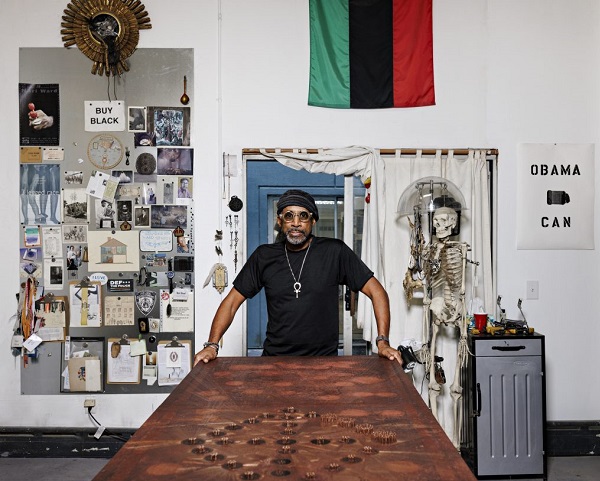
Katie White (ARTnet) interviews Jamaican-born, New York-based artist Nari Ward. The artist will be show his work in a retrospective exhibition at Milan’s Pirelli HangarBicocca in early 2024.
In a converted firehouse in Harlem, the artist Nari Ward experiments with shoestrings and scrap metal. The Jamaican-born, New York-based artist’s studio space is, in a way, a metaphor for his wide-ranging practice that uses a variety of materials—it is an oeuvre of repurposing, reimagining, and reawakening. He collects materials around his neighborhood—shopping carts, strollers, and old television sets—and works them into evocative artworks, often working at an ambitious scale, that ask challenging questions about our social and political realities.
Now, thirty years into his career, Ward, who is represented by Lehmann Maupin, is continuing this transformation process, creating art from humble objects: in March of 2024, the artist will debut a retrospective exhibition at Milan’s famed Pirelli Hangar Bicocca, the former location of the Pirelli tire factory, which was converted into formidable exhibition galleries in 2012.
Curated by Roberta Tenconi with Lucia Aspesi, the exhibition will focus on Ward’s performance and collaborative projects, including video, sound, and performative installations. The show will include acclaimed set installations the artist made as part of a dance-theater trilogy by choreographer Ralph Lemon, first presented at the Walker Art Center in 1997. Combining new and historic works, the exhibition promises to be nuanced look into Ward’s storied practice. Recently, we caught up with Ward to find out what his studio practice has been like lately.
What made you choose your particular studio over others?
I found it in the ’90s when I was looking for a space to show my installation work for an exhibition I was working on for The Studio Museum called Amazing Grace. Initially I was looking for a church, but I couldn’t find any abandoned churches. Somebody told me about this old firehouse, and I was able to get in touch with the owner. They happened to be art collectors, and they were amicable to the proposition of me using the space. [. . .]
What is the first thing you do when you walk into your studio?
I generally turn on the lights and walk back out. I don’t think about it as work in the sense that I have to clock in and out. If I don’t need to be there to complete or produce something specific, then I will go out and walk around the neighborhood or go to a place where I can watch people. I think one of my biggest hobbies is people-watching. I find inspiration from watching individuals and groups and thinking about what they’re engaged with—what they’re imagining, planning, and thinking about. My preoccupation beyond the studio is to be an observer of the rhythm and flow of people around the neighborhood. [. . .]
How does your studio environment influence the way you work?
I go through some phases where things get layered and chaotic. Things get messy, disorganized, and out of place. And I’m okay with that.
When a project is nearly complete, I don’t like messiness. I like it to be ordered and neat. So it kind of goes back and forth. I need to have things sane. And then when I get into the creative zone, I don’t mind things falling apart around me.
Describe the space in three adjectives.
Salvation, doubtful, and fortunate. [. . .]
For full article, see https://news.artnet.com/art-world/artist-nari-ward-2403425
[Artist Nari Ward shot in his Harlem studio for Lehmann Maupin.]
Katie White (ARTnet) interviews Jamaican-born, New York-based artist Nari Ward. The artist will be show his work in a retrospective exhibition at Milan’s Pirelli HangarBicocca in early 2024. In a converted firehouse in Harlem, the artist Nari Ward experiments with shoestrings and scrap metal. The Jamaican-born, New York-based artist’s studio space is, in a way, a








